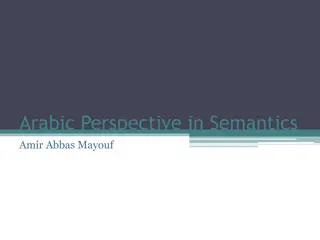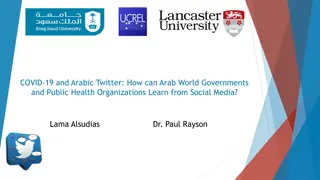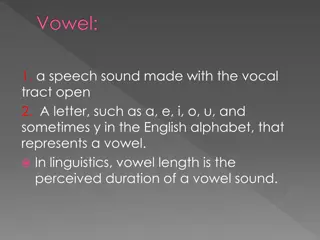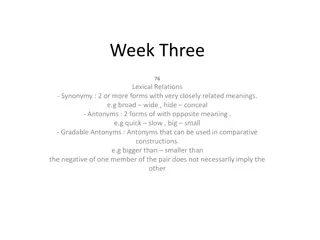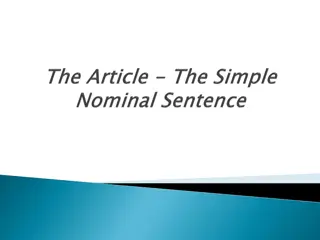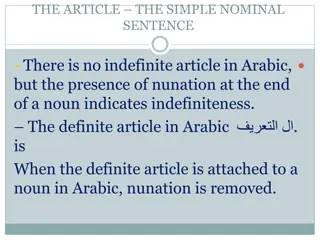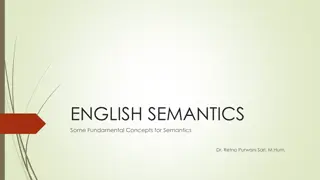Understanding Homonymy in Lexical Semantics: Examples from English and Arabic
Explore the concept of homonymy in lexical semantics through examples in both English and Arabic languages. Homonymy refers to words that share the same form but have unrelated meanings, leading to ambiguity in communication. Examples of homonyms in English and Arabic showcase how words can have multiple interpretations, emphasizing the importance of context in language understanding.
Download Presentation

Please find below an Image/Link to download the presentation.
The content on the website is provided AS IS for your information and personal use only. It may not be sold, licensed, or shared on other websites without obtaining consent from the author. Download presentation by click this link. If you encounter any issues during the download, it is possible that the publisher has removed the file from their server.
E N D
Presentation Transcript
Lexical semantics Prepared by: Mohammed Ali Ayad
Contents Homonymy Homophones Lexical relations & translation
Homonymy Homonyms are unrelated senses of the same phonological word (Saeed, 2009: 63) Homonymy refers to a word with two or more meanings. However, in this case of homonymy, the word has multiple unrelated meanings.
Examples of homonymy in English includes words like: Can - - Pupil - - Bank - a modal verb a metal or plastic container used for holding or carrying liquid part of the eye a school child a financial institution where money is kept safely for its customers ( ) the ground along the side of a river or canal as a verb meaning to expect or trust somebody to do something. - -
Examples of homonymy in Arabic liquid - a substance, such as water, etc., that is not solid and can be poured - the person who asks or begs grandfather the father of one s father or mother Seriousness the quality of being serious greet(ed) - to welcome people when meeting them Hand(ed) to give or pass something to somebody
Ask for me tomorrow, and you shall find me a grave man. Romeo and Juliet by William Shakespeare In act 3, scene 1, lines 94 95
It is worth mentioning that the ambiguity that results from the using of homonymous words is sometimes deliberately adopted to convey a message. Let us take the following verses from Arabic as a way of illustration:
In these lines of poetry, three words that have the same form and pronunciation but different meanings are intentionally used by the poet to give rhyme for the verses and to force the addressee to use his mental processes to distinguish among them; moreover, they are used as a decorative device to enrich the esthetic value of the verse. is used to refer to three different senses: sunset, a huge bucket that is full of water and a region of a low-land.
Homophones Homophones refer to lexical items that have different meanings and different spellings, but the same pronunciation.
feet write soul meet hour There buy through eight new sea feat / / / right sole meat our bye threw ate knew see tyre their tire
Examples of homophones in Arabic sons of to disobey they built stick Yahya to live on to become high
Collocation Collocation can be defined as the habitual co-occurrences of a word with certain other words of the same language (Thakur, 1999: 47) Ex: affluent society affluent family affluent man affluent country
On the verge of (tears, nervous, or breakdown) On the brink of (war, death, collapse, or disaster) Fake or false (teeth, hair, eyelash) ?
Examples of collocation in Arabic : : : : bleating of a sheep cawing of a crow a horse stable a lion's den a piece of bread a piece of meat a piece of a date : : :
a right saying to teach someone a lesson to sleep with a full stomach to burst into tears or to sob by sheer coincidence
This section will illuminate the importance of appreciating and, then, reflecting the source text semantic relations in the target text. To get the discussion started, the following example quoted from Muhsin Al-Raml s story (2009: 31) ) (Search for a Live Heart) may be given careful consideration:
In the middle of the night I go upstairs, undo my shirt, bare my chest ( )
In English, native speakers of English use different verbs for each activity, thus creating a variety of unmarked collocations, as in: to open a door to conquer a city to undo a button to unscrew a bottle to bare one s chest
This is an example of particularizing translation or translation by a hyponym in which the denotative meaning of the word used in the target text is narrower and more specific than that of the word used in the original text. Also, in English both nouns (shirt) and (chest) need a verb.
To illuminate the importance of giving full consideration to the semantic relations through the nexus of translation, the following example from Abdul-Satt rN sir s story (2009: 15) (Three Stories not for Publishing) may be considered: ST: .... >> << ... TT: When the king came in, he saw that his wife was completely naked. The moment he approached her, he realized that she was not alone. His faithful bodyguard was sleeping peacefully next to her. The guard ran out of the king s bedroom, his belly bearing more than a wide, deep gash. He died by the door.
Following is another example extracted from Ysmn bin Zarfas story (Dana and the Mice) translated into English by Fred Pragnell (2013: 1 2; bilingual edn): ST: .... TT: Dana was a careless child. She hates cleanness and likes dirtiness. Her room was always messy; her stuff was scattered on the floor. Her cupboard was open and the clothes peeped out. She was sleeping beside her stinky shoes. ...
Here is another example from Enid Blytons story Mr Twiddle in Trouble Again (1947), translated by one of the BA students at the University of Nizwa (Al-Hinai, 2015:22-23): ST: Oh, foolish man! Oh, stupid, ridiculous man! Oh, silly, silly man! I told you those boots were to be soled s-o-l-e-d, Twiddle, and you went and sold them s-o-l-d. I wanted you to get new soles put under them and you go and sell them! Twiddle, will you ever, ever, do anything really sensible? No, you never will . TT: . (sold) . (S-O-L-D) . . ! ! (soled) (S-O-LE-D) .
Here, there is an example of homophony (i.e., two words have the same pronunciation but with different meanings) in which two lexical items, viz.sold (the past participle of the verb to sell) and soled (the past participle of the rarely used verb to sole) are used in juxtaposition, thus creating a confusing situation to one of the in-text participants. Having given full consideration to such a lexical relation between these two words and their roles in developing the text, the translation trainee has intrinsically managed the text by adding (while she is spelling), thus reflecting the in-text participant s tone of indignation.
References Almanna. A, (2016). Semantics for Translation Students. New York: Peter Lang. Saeed, J. I. (1997). Semantics. Oxford: Blackwell Publishers. Damodar, T. (1999). Linguistics Simplified Semantics. Patna: Bharati Bhawan.





